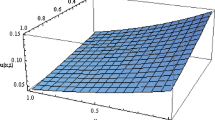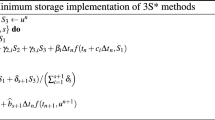Abstract
In the present study, a fractional three-step P2P1 finite element method (FEM) for solving the unsteady incompressible Navier-Stokes equations, which is a variation of P1P1 four-step splitting FEM [1], was compared with conventional one-step time-integration schemes in terms of the CPU time and convergence characteristics of an iterative solver by the solution of some benchmark problems. One-step time-integration schemes were temporarily discretized by either the Crank-Nicolson or the Adams-Bashforth method. Fractional three-step P2P1 FEM consists of three steps: a non-linear momentum equation with the pressure in the previous time step is solved to obtain an intermediate velocity field by the Crank-Nicolson method in the first step and another intermediate velocity field is calculated using the pressure in the previous time step in the second step, and a divergence-free constraint is imposed in the last step to update the pressure field, in which a symmetric saddle-point type matrix (SPTM) is solved. It was shown that the fractional three-step method is more efficient than one-step time-integration schemes because a symmetric SPTM is assembled only once during the entire computation and solved once at each time-step; further, the cost of solving the nonlinear momentum equation in a fully-implicit manner is relatively low. Furthermore, the proposed method was found to be more stable than one-step time-integration schemes as it provided stable solutions at higher CFL numbers.
Similar content being viewed by others
Abbreviations
- u :
-
Velocity vector
- ρ :
-
Pressure
- σ :
-
Stress tensor
- μ :
-
Dynamic viscosity
- ρ :
-
Density
- W :
-
Test functions
- q :
-
Weighting function of the continuity equation
- Re :
-
Reynolds number
- τ :
-
Shear stress
- Δt :
-
Time increment
- St :
-
Strouhal number
References
H. G. Choi, H. Choi and J. Y. Yoo, A fractional four-step finite element formulation of the unsteady incompressible Navier-Stokes equations using SUPG and linear equal-order element methods, Computer Methods in Applied Mechanics and Engineering, 143 (1997) 333–348.
B. Ramaswamy and T. C. Jue, Some recent trends and developments in finite element analysis for incompressible thermal flows, International Journal for Numerical Methods in Engineering, 35 (1992) 671–707.
P. Gresho, On the theory of semi-implicit projection methods for viscous incompressible flow and its implementation via a finite element method that also introduces a nearly consistent mass matrix, I-Theory, International Journal for Numerical Methods in Fluids, 11 (1990) 587–620.
J. B. Perot, An analysis of the fractional step method, Journal of Computational Physics, 108(1) (1993) 51–58.
B. Tabarrok and J. Su, Semi-implicit Taylor-Galerkin finite element methods for incompressible viscous flows, Computer Methods in Applied Mechanics and Engineering, 117 (1994) 391–410.
C.-L. Lin, H. Lee, T. Lee and L. J. Weber, A level set characteristic Galerkin finite element method for free surface flows, International Journal for Numerical Methods in Fluids, 49 (2005) 521–547.
R. F. Hanby, D. J. Silvester and J. W. Chew, A comparison of coupled and segregated iterative solution techniques for incompressible swirling flow, International Journal for Numerical Methods in Fluids, 22 (1996) 353–373.
Y. S. Nam, H. G. Choi, J. Y. Yoo and J. Y. Ailu, Preconditioning for the finite element formulation of the incompressible Navier-Stokes equations, Computer Methods in Applied Mechanics and Engineering, 191 (2002) 4323–4339.
F. Brezzi, On the existence, uniqueness and approximation of saddle point problems arising from lagrange multipliers, R.A.I.R.O. Analyse Numérique, 8 (1974) 129–151.
H. G. Choi, Splitting method for the combined formulation of the fluid-particle problem, Computer Methods in Applied Mechanics and Engineering, 190 (2000) 1367–1378.
J. Sung, H. G. Choi and J. Y. Yoo, Time-accurate computation of unsteady free surface flows using an ALE-segregated equal-order FEM, Computer Methods for Applied Mechanics and Engineering, 190 (2000) 1425–1440.
H. G. Choi and D. D. Joseph, Fluidization by lift of 300 circular particles in plane poiseuille flow by direct numerical simulation, Journal of Fluid Mechanics, 438 (2001) 101–128.
H. A. van der Vorst, Bi-CGSTAB: a fast and smoothly converging variant of Bi-CG for the solution of non-symmetric linear systems, SIAM Journal on scientific and Statistical Computing, 12 (1992) 631–644.
D. O. Dahl and S. Ø. Wille, An ILU preconditioner with coupled node fill-in for iterative solution of the mixed finite element formulation of the 2D and 3D Navier-Stokes equations, International Journal for Numerical Methods in Fluids, 15 (1992) 525–544.
G. F. Carey and T. J. Oden, Finite Elements: Fluid Mechanics, Prentice-Hall, Inc., 4 (1986).
H. Choi and P. Moin, Effects of the computational time step on numerical solutions of turbulent flow, Journal of Computational Physics, 113 (1994) 1–4.
M. T. Nguyen, B. J. Jeon, H. J. Chang and S. W. Lee, Domain decomposition based parallel computing for multi-scale coronary blood flow simulations, Computers and Fluids, 191 (2019) 104254.
J. R. Lee, H. Y. Yoon and H. G. Choi, Domain decomposition parallel computing for transient two-phase flow of nuclear reactorst, Journal of Mechanical and Science and Technology, 30(5) (2016) 2045–2057.
H. G. Choi, S. W. Kang and J. Y. Yoo, Parallel large eddy simulation of turbulent flow around MIRA model using linear equal-order finite element method, International Journal for Numerical Methods in Fluids, 56 (2008) 823–843.
H. K. Yoon, J. R. Lee, H. Kim, I. K. Park, C. H. Song, H. K. Cho and J. J. Jeong, Recent improvements in the CUPID code for a multi-dimensional two-phase flow analysis of nuclear reactor components, Nuclear Engineering and Technology, 46(5) (2014) 655–666.
U. Ghia, K. N. Ghia and C. T. Shin, High-Re solutions for incompressible flow using the Navier-Stokes equations and a multigrid method, Journal of Computational Physics, 48 (1982) 387–411.
N. Kumar, J. C. Kalita and A. K. Dass, HOC computation of two-sided lid-driven cavity flow, The Proceedings of the Second International Conference on Computational Mechanics and Simulation, 2 (2006) 1695–1700.
D. Kim and H. Choi, A second-order time-accurate finite volume method for unsteady incompressible flow on hybrid unstructured grids, Journal of Computational Physics, 162 (2000) 411–428.
E. B. Becker, G. F. Carey and J. T. Oden, Finite Elements: An Introduction, First Ed., Prentice-Hall, Englewood Cliffs, USA (1983).
C. H. K. Williamson, Oblique and parallel modes of vortex shedding in the wake of a circular cylinder at low Reynolds numbers, Journal of Fluid Mechanics, 206 (1989) 579–627.
M. Braza, P. Chassaing and H. H. Minh, Numerical study and physical analysis of the pressure and velocity fields in the near wake of a circular cylinder, Journal of Fluid Mechanics, 165 (1986) 79–130.
G. E. Karniadakis and G. S. Triantafyllou, Frequency selection and asymptotic states in laminar wakes, Journal of Fluid Mechanics, 199 (1989) 441–469.
K. Kwon and H. Choi, A passive control of vortex shedding using a splitter plate attached to a circular cylinder, Proceedings of the KSME Fall Annual Meeting 1994 (1994) 502–507.
T. A. Johnson and V. C. Patel, Flow past a sphere up to a Reynolds number of 300, J. Fluid Mech., 378 (1999) 19–70.
Acknowledgments
This study was supported by the Research Program funded by the Seoul Tech (Seoul National University of Science and Technology).
Author information
Authors and Affiliations
Corresponding author
Additional information
Sang T. Ha received his Ph.D. in Mechanical Engineering at Seoul National University of Science and Technology, Korea. He is currently a researcher in the Department of Mechanical Engineering at Le Quy Don technical University, Ha noi, Viet Nam. His research interests include computational fluid dynamics, fluid-structure interaction and multi-grid method.
Rights and permissions
About this article
Cite this article
Cho, M.H., Ha, S.T., Yoo, J.Y. et al. A numerical experiment on the stability and convergence characteristics of some splitting mixed-finite element methods for solving the incompressible Navier-Stokes equations. J Mech Sci Technol 37, 4729–4740 (2023). https://doi.org/10.1007/s12206-023-0827-5
Received:
Revised:
Accepted:
Published:
Issue Date:
DOI: https://doi.org/10.1007/s12206-023-0827-5




